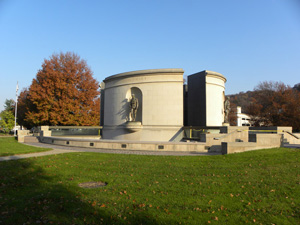

Remember...
Paul Earnest King
1925-1944
"They fight not for the lust of conquest. They fight to end conquest. They fight to liberate."
President Franklin D. Roosevelt
 |
Remember...Paul Earnest King
|
Paul Earnest King, whose hometown was Racine, Boone County, West Virginia, was born on March 31, 1925, to Jeremiah Ernest ("Jerry") and Dolly Ethel Meadows King, who were married in 1920. Paul had an older sister, Irene. The 1930 Federal Census shows the growing family to include Irene, Paul, Clarence, and Mary, and, by 1940, the family had grown to include Cecil, Betty, Loretta, and Bobby, the youngest son/brother. Another daughter/sister, Shirley, is mentioned in Paul�s death notice, but is not referenced in either of the census documents, because she was born after 1940. Jerry King was deceased in 1941, which may account for the fact that by 1943 Paul was living independently in Charleston. That year he registered for the draft; his draft card shows that he was employed by C. A. Lewis. U.S. World War II Army Enlistment Records, 1938-1946, describe his civilian occupation to be in the category of "semiskilled chauffeurs and drivers, bus, taxi, truck, and tractor."
In World War II, Paul King served his country in the U.S. Army in Fox Company, 314th Regiment, 79th Division. He was originally assigned as replacement personnel (per the company's morning report of April 5, 1944) prior to the company's departure for the European Theater. He was among several men assigned to the company at the Boston port of embarkation, Camp Myles Standish. They were headed to England, and, ultimately, the greatest invasion that Europe had ever seen: D-Day, June 6, 1944.
By June 25, Cherbourg had been surrounded and isolated:
On 25 June, at approximately 0700, a German medical officer, adjutant of the Naval Hospital at Cherbourg, accompanied by a captured American Air Forces officer, came through the lines of the 9th Division to request that the hospital be spared from shelling and that blood plasma be sent for the wounded Americans there. He was given the plasma and returned to Cherbourg bearing also a demand for the immediate surrender of the city: "The Fortress Cherbourg is now surrounded and its defenses have been breached. The city is now isolated.... You are tremendously outnumbered and it is merely a question of time when Cherbourg must be captured. The immediate unconditional surrender of Cherbourg is demanded...."As the German commander received this demand, the 12th Infantry was storming Tourlaville and pushing on to the coast; the 314th Infantry was assaulting Fort du Roule; the 39th Infantry was fighting its way into Octeville; and the 47th Infantry was battering at the western outskirts of the city near Equeurdreville.
The outstanding event of 25 June was the capture of Fort du Roule. Built high and secure into the steep rock promontory which stands immediately back of the city, the fort dominated the entire harbor area and was a formidable-appearing bastion, particularly from the sea. Fort du Roule was primarily a coastal fortress, with its guns housed in the lower levels of the fort pointing seaward. However, it was also defended against land attack from its top level, which mounted automatic weapons and mortars in concrete pillboxes, and enjoyed a favorable defensive position with the steep sides of the promontory restricting the approach to the fort along a solitary ridge. Only the top level of the fort was visible from the land side. A few hundred yards southeast of the fort the Germans had dug an antitank ditch. Several hundred yards farther south was a stream bed, still another hindrance to the attackers.
At 0800 on 25 June one squadron of P-47's bombed Fort du Roule, but for the most part the planes overshot their mark and no damage was done to the subterranean tunnels housing the guns. The land attack was undertaken by the 2d and 3d Battalions of the 314th Infantry. The 3d Battalion at first attempted an attack straight across the draw which lies approximately 700 yards south of the fort. But on reaching the slopes which lead down into the draw the battalion was met with a tremendous volume of small-arms fire. This fire originated from a row of well dug-in positions along an east-west trail on the forward slope and just a few yards beyond the stream bed. Resistance from these positions came as a surprise, and there was at the moment nothing to counter this fire except the 3d Battalion's own small arms and mortars, for the artillery supporting the attack (the 311th Field Artillery Battalion) was firing on the fort itself, 700 yards beyond. The resistance from these bunkers was finally eliminated by the concentration of all machine guns in the 2d and 3d Battalions. Few Germans escaped to the fort. Almost all of them were wiped out by the great volume of automatic fire. (United States Army Center of Military History, "The Fall of Cherbourg," Utah Beach to Cherbourg [6 June-27June 1944] [Washington, DC: Department of the Army, 1948, 1990], 189-190, accessed 6 August 2019, https://history.army.mil/books/wwii/utah/utah11.htm.)
Article prepared by Patricia Richards McClure
December 2019

West Virginia Archives and History welcomes any additional information that can be provided about these veterans, including photographs, family names, letters and other relevant personal history.